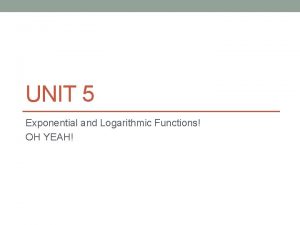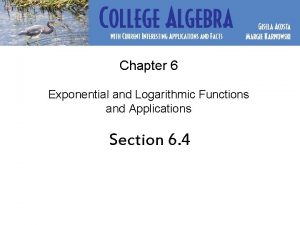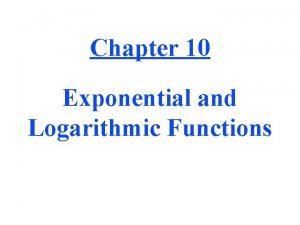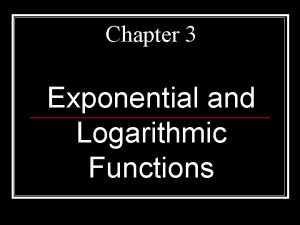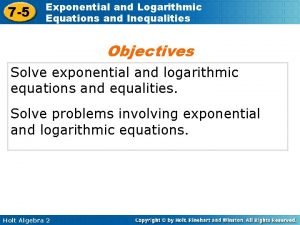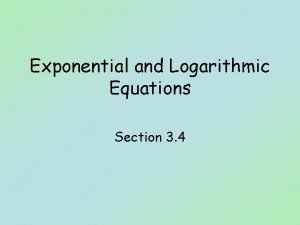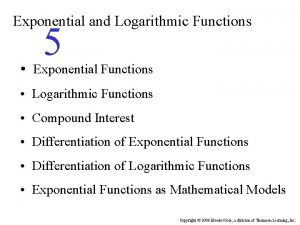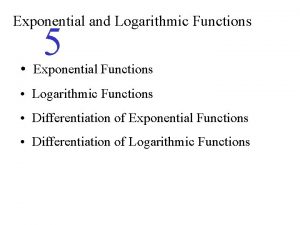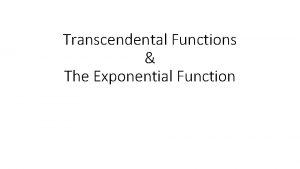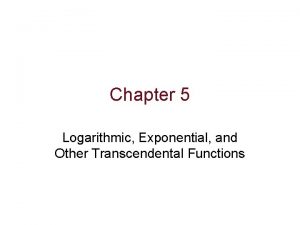P 5 Logarithmic Exponential and Other Transcendental Functions


































- Slides: 34

P 5 Logarithmic, Exponential, and Other Transcendental Functions Copyright © Cengage Learning. All rights reserved.

5. 3 Inverse Functions Copyright © Cengage Learning. All rights reserved.

Objectives n Verify that one function is the inverse function of another function. n Determine whether a function has an inverse function. n Find the derivative of an inverse function. 3

Inverse Functions The function f (x) = x + 3 from A = {1, 2, 3, 4} to B = {4, 5, 6, 7} can be written as By interchanging the first and second coordinates of each ordered pair, you can form the inverse function of f. This function is denoted by f – 1. It is a function from B to A and can be written as 4

Inverse Functions Note that the domain of f is equal to the range of f – 1, and vice versa, as shown in Figure 5. 9. The functions f and f – 1 have the effect of “undoing” each other. That is, when you form the composition of f with f – 1 or the composition of f – 1 with f, you obtain the identity function. f (f – 1(x)) = x and f – 1(f (x)) = x Figure 5. 9 5

Inverse Functions 6

Inverse Functions Here are some important observations about inverse functions. 1. If g is the inverse function of f, then f is the inverse function of g. 2. The domain of f – 1 is equal to the range of f, and the range of f – 1 is equal to the domain of f. 3. A function need not have an inverse function, but when it does, the inverse function is unique. 7

Inverse Functions You can think of f – 1 as undoing what has been done by f. For example, subtraction can be used to undo addition, and division can be used to undo multiplication. So, are inverse functions of each other and are inverse functions of each other. 8

Example 1 – Verifying Inverse Functions Show that the functions are inverse functions of each other. and Solution: Because the domains and ranges of both f and g consist of all real numbers, you can conclude that both composite functions exist for all x. The composition of f with g is 9

Example 1 – Solution cont'd The composition of g with f is 10

Example 1 – Solution cont'd Because f (g(x)) = x and g(f (x)) = x, you can conclude f and g are inverse functions of each other (see Figure 5. 10). Figure 5. 10 11

Inverse Functions In Figure 5. 10, the graphs of f and g = f – 1 appear to be mirror images of each other with respect to the line y = x. The graph of f – 1 is a reflection of the graph of f in the line y = x. This idea is generalized in the next theorem. 12

Existence of an Inverse Function 13

Existence of an Inverse Function Not every function has an inverse function, and Theorem 5. 6 suggests a graphical test for those that do—the Horizontal Line Test for an inverse function. This test states that a function f has an inverse function if and only if every horizontal line intersects the graph of f at most once (see Figure 5. 12). Figure 5. 12 14

Existence of an Inverse Function The next theorem formally states why the Horizontal Line Test is valid. 15

Example 2(a) – The Existence of an Inverse Function From the graph of f (x) = x 3 + x – 1 shown in Figure 5. 13(a), it appears that f is increasing over its entire domain. To verify this, note that the derivative, f'(x) = 3 x 2 + 1, is positive for all real values of x. So, f is strictly monotonic, and it must have an inverse function. Figure 5. 13 16

Example 2(b) – The Existence of an Inverse Function cont'd From the graph of f (x) = x 3 – x + 1 shown in Figure 5. 13(b), you can see that the function does not pass the Horizontal Line Test. In other words, it is not one-to-one. For instance, f has the same value when x = – 1, 0, and 1. Figure 5. 13 So, by Theorem 5. 7, f does not have an inverse function. 17

Existence of an Inverse Function The following guidelines suggest a procedure for finding an inverse function. 18

Example 3 – Finding an Inverse Function Find the inverse function of Solution: From the graph of f in Figure 5. 14, it appears that f is increasing over its entire domain, . To verify this, note that is positive on the domain of f. So, f is strictly monotonic and it must have an inverse function. Figure 5. 14 19

Example 3 – Solution cont'd To find an equation for the inverse function, let y = f (x), and solve for x in terms of y. 20

Example 3 – Solution The domain of f – 1 is the range of f, which is cont'd . You can verify this result as shown. 21

Existence of an Inverse Function You are given a function that is not one-to-one on its domain. By restricting the domain to an interval on which the function is strictly monotonic, you can conclude that the new function is one-to-one on the restricted domain. 22

Example 4 – Testing Whether a Function Is One-to-One Show that the sine function f(x) = sin x is not one-to-one on the entire real number line. Then show that [–π/2, π/2] is the largest interval, centered at the origin, on which f is strictly monotonic. 23

Example 4 – Solution It is clear that f is not one-to-one, because many different x-values yield the same y-value. For instance, sin(0) = 0 = sin(π) Moreover, f is increasing on the open interval (–π/2, π/2), because its derivative f'(x) = cos x is positive there. 24

Example 4 – Solution cont'd Finally, because the left and right endpoints correspond to relative extrema of the sine function, you can conclude that f is increasing on the closed interval [–π/2, π/2] and that on any larger interval the function is not strictly monotonic (see Figure 5. 15). Figure 5. 15 25

Derivative of an Inverse Function 26

Derivative of an Inverse Function The next two theorems discuss the derivative of an inverse function. 27

Derivative of an Inverse Function 28

Example 5 – Evaluating the Derivative of an Inverse Function Let a. What is the value of f – 1(x) when x = 3? b. What is the value of (f – 1)'(x) when x = 3? Solution: Notice that f is one-to-one and therefore has an inverse function. a. Because f (x) = 3 when x = 2, you know that f – 1(3) = 2. 29

Example 5 – Solution cont'd b. Because the function f is differentiable and has an inverse function, you can apply Theorem 5. 9 (with g = f – 1) to write Moreover, using you can conclude that 30

Derivative of an Inverse Function In Example 5, note that at the point (2, 3), the slope of the graph of f is m = 4, and at the point (3, 2), the slope of the graph of f – 1 is m = as shown in Figure 5. 16 31

Derivative of an Inverse Function In general, if y = g(x) = f – 1(x), then f (y) = x and f'(y) = follows from Theorem 5. 9 that . It This reciprocal relationship is sometimes written as 32

Example 6 – Graphs of Inverse Functions Have Reciprocal Slopes Let f(x) = x 2 (for x ≥ 0), and let. Show that the slopes of the graphs of f and f – 1 are reciprocals at each of the following points. a. (2, 4) and (4, 2) b. (3, 9) and (9, 3) Solution: The derivative of f and f – 1 are f'(x) = 2 x and a. At (2, 4), the slope of the graph of f is . At (4, 2), the slope of the graph of f – 1 is 33

Example 6 – Solution cont'd b. At (3, 9), the slope of the graph of f is f'(3) = 2(3) = 6. At (9, 3), the slope of the graph of f – 1 is So, in both cases, the slopes are reciprocals, as shown in Figure 5. 17 34
 Logarithmic exponential and other transcendental functions
Logarithmic exponential and other transcendental functions Chapter 5 logarithmic exponential and other
Chapter 5 logarithmic exponential and other Integration of exponential
Integration of exponential Unit 8 exponential and logarithmic functions
Unit 8 exponential and logarithmic functions Unit 5 exponential and logarithmic functions answers
Unit 5 exponential and logarithmic functions answers What kind of pattern
What kind of pattern Chapter 6 exponential and logarithmic functions answers
Chapter 6 exponential and logarithmic functions answers Chapter 4 exponential and logarithmic functions
Chapter 4 exponential and logarithmic functions Site:slidetodoc.com
Site:slidetodoc.com Chapter 10 exponential and logarithmic functions answers
Chapter 10 exponential and logarithmic functions answers Property of equality for exponential functions
Property of equality for exponential functions Transforming exponential and logarithmic functions
Transforming exponential and logarithmic functions The inverse of exponential function is a composite function
The inverse of exponential function is a composite function Lesson 5-2
Lesson 5-2 Expanding logarithmic functions
Expanding logarithmic functions Chapter 9 exponential and logarithmic functions answer key
Chapter 9 exponential and logarithmic functions answer key Chapter 9 exponential and logarithmic functions answer key
Chapter 9 exponential and logarithmic functions answer key Chapter 5 exponential and logarithmic functions answer key
Chapter 5 exponential and logarithmic functions answer key Solving exponential calculator
Solving exponential calculator Chapter 5 exponential and logarithmic functions
Chapter 5 exponential and logarithmic functions Chapter 3 exponential and logarithmic functions
Chapter 3 exponential and logarithmic functions Differentiation rules
Differentiation rules 7-5 exponential and logarithmic equations
7-5 exponential and logarithmic equations 7-5 exponential and logarithmic equations and inequalities
7-5 exponential and logarithmic equations and inequalities Logarithmic inequality example
Logarithmic inequality example Exponential equation example
Exponential equation example Exponential and logarithmic equations and inequalities
Exponential and logarithmic equations and inequalities Modeling with exponential and logarithmic equations quiz
Modeling with exponential and logarithmic equations quiz 7-3 logarithms and logarithmic functions
7-3 logarithms and logarithmic functions 3-4 exponential and logarithmic equations
3-4 exponential and logarithmic equations 3-4 exponential and logarithmic equations
3-4 exponential and logarithmic equations Logarithm
Logarithm Curve fitting with exponential and logarithmic models
Curve fitting with exponential and logarithmic models Log to exponential form
Log to exponential form Exponential inequality definition
Exponential inequality definition




